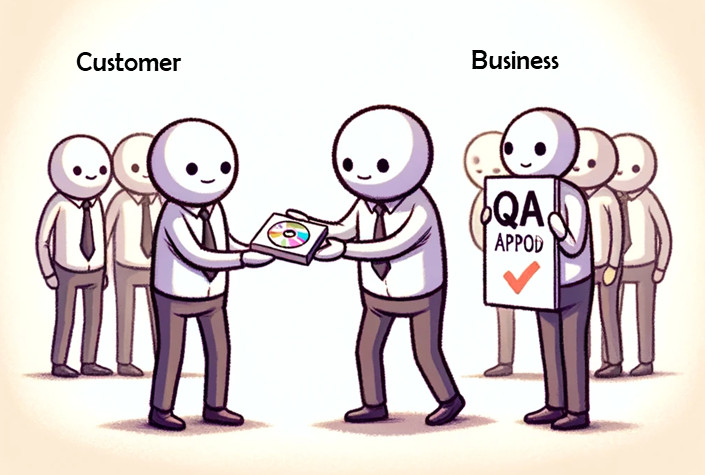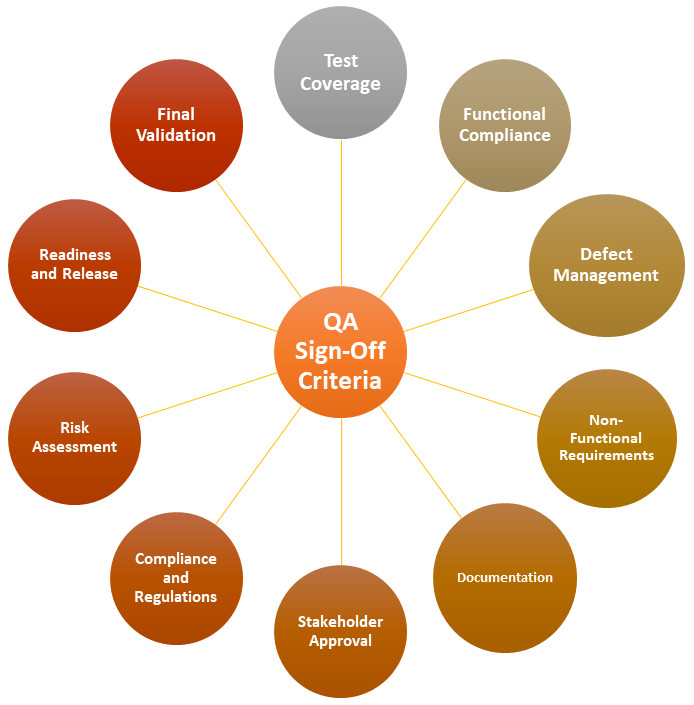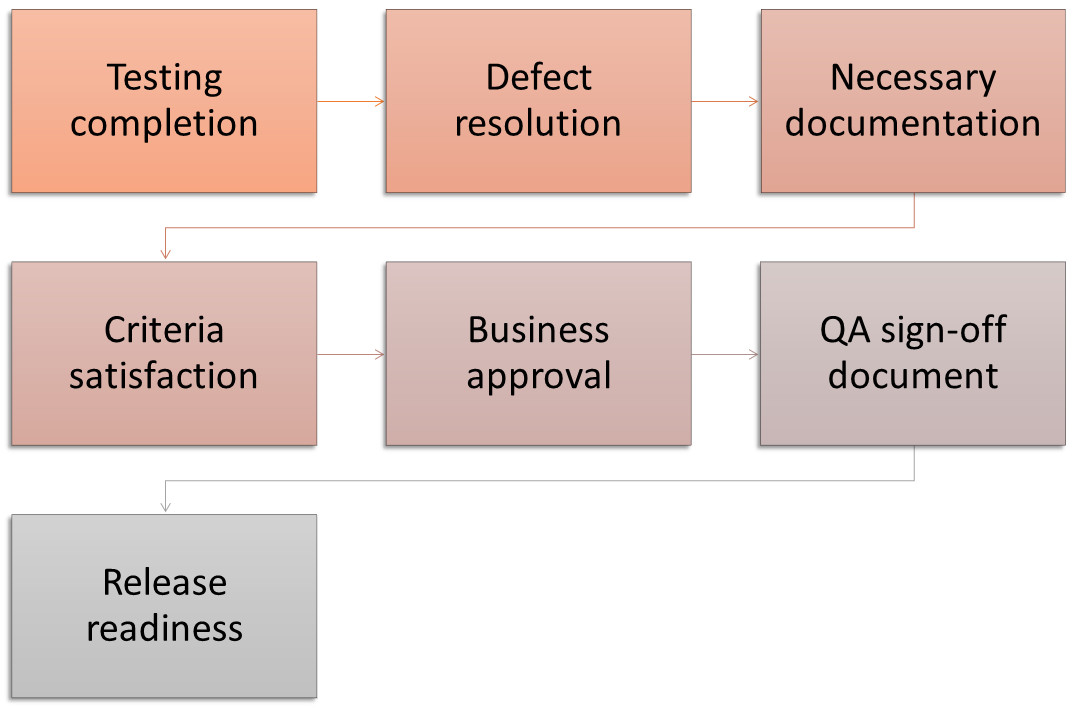QA Sign-Off: The Final Seal of Approval Explained
|
|
Imagine you’re planning to throw a big, elaborate party. The crew has decorators, caterers, logistics management, and wedding planners. Before the event, you need to ensure everything is in place and ready for your guests.
The QA sign-off is like the final walkthrough you do with the party planners- the QA team, to ensure everything meets your high standards. QA sign-off is a critical milestone in any product development lifecycle. Let’s see what makes it so vital.

Definition of QA sign-off
The QA sign-off is when the QA team formally approves and documents that a product has been tested and meets the established quality standards. This sign-off is part of the quality management process and serves as the final seal of approval before the product is released to the market or handed off to the next phase of development or deployment.
Criteria for QA sign-off
Here is a general list of what to consider during the QA sign-off.

- Test Coverage: All test plans and test cases should be executed. This also includes automated test cases.
- Functional Compliance: Here, you need to monitor whether the expected features have been delivered and are working as expected.
- Defect Management: The critical bugs should be resolved and retested before the software release. There also needs to be a plan of action for the low-priority defects.
- Non-Functional Requirements: Includes performance, security, and usability of an application. Read here the difference between functional and non-functional testing.
- Documentation: Includes the artifacts such as test plans, release notes, and test runs that should be completed.
- Stakeholder Approval: The approval of relevant stakeholders like the customer and the business team should be taken before releasing the software.
- Compliance and Regulations: Different industries have their own regulations that must be followed. This also includes licensing and any legal requirements. Read here how to develop an ADA-compliant app.
- Risk Assessment: If there are any known risks, they should be socialized with the stakeholders, and contingency plans should be made to tackle them as and when they pose a threat.
- Readiness and Release: This includes setting up the environment and preparing the customer support team.
- Final Validation: A final go/no-go meeting, along with the QA sign-off, is required to decide the final course of action.
General flow of the QA sign-off process
Here’s what typically happens in a QA Sign-Off process.

1. Testing Completion
Before a sign-off, the QA team ensures that all planned tests have been executed. This includes functional testing, performance testing, security testing, usability testing, and any other relevant testing types outlined in the test plan.
2. Defect Resolution
All critical bugs and issues identified during the testing phase are fixed and retested. There can be non-critical bugs that are not fixed, which are documented, and a plan is made for their eventual resolution.
3. Documentation
All test cases and their outcomes are documented. This documentation includes test plans, test case execution reports, defect reports, and metrics that show test coverage and quality.
4. Criteria Satisfaction
The product must meet the acceptance criteria that were defined before the development began. These criteria may include performance benchmarks, functionality requirements, compliance standards, and other product-specific goals.
5. Business Approval
In many cases, the business stakeholders also review the product and the testing outcomes to ensure that it meets the business requirements and that they are satisfied with its quality.
6. QA Sign-Off Document
The QA team prepares a sign-off document that typically includes the following information.
- Project Details: Project name, version, release date, etc.
- Test Summary: Including total tests conducted, number of tests passed/failed, and test coverage.
- Outstanding Issues: A summary of known issues still present in the release, along with their impact and mitigation plan.
- Approval: A formal statement that QA testing is complete and the product meets the necessary quality standards.
- Signatures: The document is signed and dated by the QA lead or manager to indicate approval formally.
7. Release Readiness
With the QA sign-off, the product is generally considered ready for release. The release team can then proceed with deployment, whether making the software available for download, pushing it to production servers, or shipping it to customers.
Types of QA sign-offs
Sign-offs are categorized into different types, reflecting the QA team’s confidence in the product’s readiness for release. The decision behind each is typically based on risk assessment, considering the impact of unresolved issues against the project timeline, business needs, and customer expectations.
However, a thing to note is that the terminologies of ‘positive’ and ‘negative’ may not be used across organizations and might vary. However, the sentiment is likely to remain the same.
Positive sign-off
A positive sign-off occurs when the product has passed all the critical test cases and meets the predefined acceptance criteria. It means that the QA team has found that the software functions according to requirements, all major defects have been resolved, and any remaining issues are minor and manageable. The product is deemed ready for release or moving to the next development phase.
Going back to our analogy of organizing an elaborate, high-profile party. Imagine that after your final walkthrough of the party venue with your party planners- the QA team, you find that everything is precisely as it should be. The decorations are stunning, the music is just right, the food is delicious, and the security measures are tight. You’ve checked every corner, and your party checklist’s essential elements, test cases, have been ticked off perfectly. The party planners give you a thumbs up or a positive sign-off, assuring your guests will have a great time without significant hiccups. You confidently give the green light for the party or the product release to start.
Negative sign-off
A negative sign-off happens when the product does not meet the necessary quality standards or acceptance criteria. Critical bugs may still be outstanding, or the product may not function as required. The QA team does not approve the product’s release in this case. A negative sign-off typically leads to a review of the outstanding issues, additional development work to fix the problems, and further rounds of testing.
Back to our party analogy, let’s say during your final checks, you find several significant issues. The main attraction, a live band, hasn’t shown up, which is a critical bug, and the caterers have brought the wrong food, a major functionality issue. These significant problems can’t be ignored because they would ruin the party or the user experience. The party planners or the QA team advise you that starting the party under these conditions is not wise. They give a heads-down or a negative sign-off, recommending that you postpone the event, equivalent to holding back the release, until these critical issues are fixed, and the experience can meet your guests’ expectations.
Conditional sign-off
Sometimes, the QA team might give a conditional sign-off. This is a middle ground where the product has met most of the acceptance criteria, but some non-critical issues still need to be solved. The sign-off is granted on the condition that these issues are accepted as known defects to be addressed in future updates or that certain conditions are met before or shortly after the release. The stakeholders agree to these conditions before proceeding.
In another scenario of our party analogy, during your final checks, you notice a few minor issues: some decorations are not quite to the theme, which are minor bugs, and perhaps the backup singer is a bit off-key, a non-critical issue. However, the main components of your party are in place, and everything critical to the event’s success is as planned. The party planners give you a nod or a conditional sign-off, but they make you aware of these minor issues. You agree to proceed with the party or release; knowing these little details won’t prevent the guests from enjoying the main event. You might also agree to fix these minor issues discreetly during the party as post-release patches or address them more thoroughly in your next party or future product update.
Important considerations
When it comes to QA sign-offs, there are certain things you can keep in mind.
- Risk Assessment: QA sign-off also includes an assessment of any potential risks associated with the release. QA provides insights into what could go wrong and the likelihood of such events.
- Regulatory Compliance: For products in regulated industries, QA sign-off may also involve ensuring that the product complies with relevant regulations and standards.
- Customer Feedback: In some development methodologies, such as Agile, customer feedback may be incorporated into the sign-off process.
- Post-Release Support Plan: A plan should be in place for handling any issues that arise post-release, including customer support and potential hotfixes.
How does automated testing ease the QA sign-off process?
From the above discussion, you must have gathered by now that the QA sign-off is not to be taken lightly. Hence, you need practices and tools that assure the most reliable results to make this judgment process easier.
By using tools for various QA activities like testing, you can ascertain the accuracy of the outcome. Nothing against manual testing, but indeed, you are familiar with the sheer volume and frequency of testing that needs to be done to ensure that an application is operating at its highest potential. In this environment, the chances of human error and slowness in testing, leading to less test coverage, are high.
With the help of test automation tools, you can delegate repetitive testing activities to machines and rely on their issue and accuracy to get the job done. One such helpful tool that helps make the most out of available resources is testRigor.
testRigor for automation testing
testRigor leverages modern intelligent AI capabilities to make sure that you can create, run, and maintain tests comfortably and quickly. This, in turn, helps get accurate and timely results and reports to prepare the QA sign-off document.
Whenever someone mentions using a new tool, you might worry about costs like training team members, licenses, and configuration setups. But with testRigor, the process is very smooth and fast. This is where AI comes in handy. Everyone in your team can create test cases using plain English statements. A rich set of commands and features allows you to easily automate all kinds of functional, end-to-end, cross-browser, cross-platform, and UI-based test scenarios. Thus, you need not hire additional test automation staffing to do this and can instead leverage your in-house manual testers. Anyone in your team can create test cases using the generative AI capabilities of testRigor in plain English.
Using this tool, you can rest assured knowing there will not be flakey test runs as testRigor takes care of it through self-healing. The tool will provide you with a speedy execution and give you a test report as well to quickly help with the sign-off process.
Conclusion
QA sign-off is a responsibility that is not to be taken lightly, as it directly impacts the future of the product and business. In some cases, it is usually a joint responsibility of the QA team, the business stakeholders, and even the customers. If you wish to propel your business, make sure to use all the help you can get in terms of test automation tools for various aspects of QA, bifurcating the manual load, and improving the product quality manifolds.
| Achieve More Than 90% Test Automation | |
| Step by Step Walkthroughs and Help | |
| 14 Day Free Trial, Cancel Anytime |












